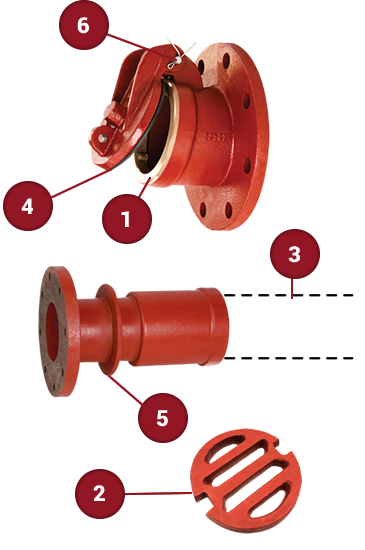Wall Type Pressure Relief Valves
Performance Under Pressure
Installed in the side walls of water treatment tanks, wall type pressure relief valves relieve groundwater pressure on the exterior sides of a tank. This ensures concrete tanks don’t begin to float, which can cause cracking and other serious issues.
Unique Features
Our strong, flat surface lid with resilient to bronze seating outperforms typical rubber to rubber seals, which are very wide and difficult to seal properly.
Designed for easy maintenance, the grate can be accessed simply by opening the lid and reaching in. No tools are required!
With the ability to extend to match exact wall thickness, our valve eliminates the need for extra field work.
Our gasket won't collapse under water pressure because it is bonded to the lid and reinforced by a stainless steel washer.
Because our water stop is cast into the wall pipe, we can help prevent water from leaking around the outside of the wall pipe.
All hardware on the valve is made of stainless steel so it won’t corrode and bind up the valve.

Materials
Cast Iron
- Epoxy coating on valve and wall pipe
- Machined bronze seat
316 Stainless Steel
- Machined stainless steel seat
Operation
The valve opens as a result of hydrostatic pressure outside the wall of a tank exceeding the inside pressure. The opening action allows water to flow into the tank thus equalizing pressure both inside and outside of the tank.
Maintenance
The valve requires no lubrication. There is no requirement for regular maintenance. Valve seats should be visually inspected for damage when the valve is accessible.
Installation
Valves are to be mounted vertically only. Care should be taken to prevent damage to the seats when placing in form and pouring concrete. Cover and grate should be installed in the body, turned a quarter turn, and tested to be sure cover and grate cannot lift off body.
Parts
Parts are available by request. Please contact us for more information.
Application Notes
- How fast can the water table rise around an empty tank? Think of nearby rivers rising or coming through a dike (A factor in calculating how much flow you must allow into the tank).
- How fast could you pump out a tank that had a high water table around it? (Another factor in determining inflow requirements.)
- What is your drainage like around and under the tank? How easily can ground water flow to the tank relief valves? (This may influence how many valves you install. Poor drainage may allow any particular valve to drain only a small area around it.)
- How strong is your structure? What is the tolerance for flotation (pipes, etc.). What is buoyancy of the tank? What pressures from underneath can the floor handle without breaking?
The above is offered only as a starting point in your design considerations.
The permanent nature of these valves should make you consider carefully the brand of valve you install. Troy Valve tank relief valves are a very inexpensive and cost effective way to protect your project. The cost of some floor or wall relief valves will be far less than the cost of losing a tank or basin due to floating.
You Have A Problem. We Have The Solution.
Confidence